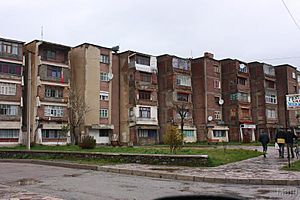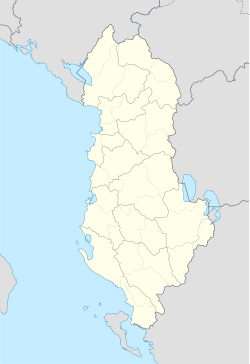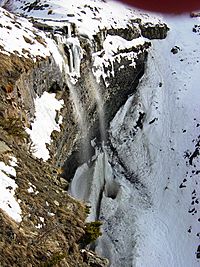Kolonjë facts for kids
Quick facts for kids
Kolonjë
|
||
|---|---|---|

Ersekë, the main settlement of Kolonjë
|
||
|
||
| Country | ||
| County | Korçë | |
| Area | ||
| • Municipality | 865 km2 (334 sq mi) | |
| Population
(2011)
|
||
| • Municipality | 11,070 | |
| • Municipality density | 12.798/km2 (33.15/sq mi) | |
| Demonym(s) | Kolonjar/e | |
| Time zone | UTC+1 (CET) | |
| • Summer (DST) | UTC+2 (CEST) | |
| Postal Code |
7401
|
|
| Area Code | (0)812 | |
Kolonjë is a municipality (like a large district) in southeastern Albania. It is part of Korçë County. This area was formed in 2015 by joining several smaller municipalities. These included Barmash, Çlirim, Ersekë, Leskovik, Mollas, Novoselë, Qendër Ersekë, and Qendër Leskovik.
The main town and administrative center of Kolonjë is Ersekë. In 2011, the total population of Kolonjë was about 11,070 people. The municipality covers an area of around 865 square kilometers (about 334 square miles). Kolonjë is also known as a special ethnographic region, meaning it has unique cultural traditions.
Before 2000, Kolonjë was a district of Albania. These districts were later changed into larger counties.
Contents
Where is Kolonjë Located?
Kolonjë is found in the southeastern part of Albania. Its main town, Ersekë, is also its capital. Another important town in this area is Leskovik, located to the south.
Kolonjë shares its borders with Korçë to the north. To the east, it borders Greece. The Greek areas nearby include Kastoria and Ioannina. The town of Ersekë sits at the base of Gramos mountain. This mountain is Albania's fourth-highest, with its peak reaching 2,525 meters (8,284 feet) above sea level.
A Look at Kolonjë's History
During the Middle Ages, there was a region called Koloneia. It was in the mountains south of Korçë and north of Konitsa and Kastoria. This area was on the western slopes of the Grammos mountain range. The Byzantine Empire even built a military base there.
Around the year 1018, after the Byzantine Empire took over Bulgaria, Emperor Basil II created new administrative areas called "themes." One of these was Koloneia. He settled former prisoners of war there. This helped protect the Byzantine lands in Epirus from future attacks. By the 1040s, the Koloneia theme became part of a larger region called the Duchy of Dyrrachion.
After the city of Constantinople was attacked in 1204, the Byzantine Empire was divided. Koloneia was given to the Republic of Venice. However, it soon came under the control of the Despotate of Epirus. It became one of their important regions. After a battle in 1259, Koloneia was given to the Empire of Nicaea.
An old text from Emperor John VI Kantakouzenos (who ruled from 1347-1354) mentions local Albanians. He wrote about "Albanian nomads" from Koloneia meeting him around February 1328. This shows that Albanian people have lived in this area for a very long time.
Some historians believe that a major group of Albanians moved into Kolonjë in the 14th century. The name Kolonja itself might come from the Roman period of the area.
Towns and Villages in Kolonjë
Kolonjë municipality includes many smaller towns and villages. Here is a list of some of them:
- Barmash
- Bezhan
- Blush
- Borovë
- Butkë
- Çlirim
- Ersekë
- Gjonc
- Gërmenj
- Gostivisht
- Helmës
- Kabash
- Kagjinas
- Kaltanj
- Kamnik
- Kodras
- Kozel
- Kreshovë
- Kurtez
- Lashovë
- Lëngëz
- Lënckë
- Leshnjë
- Leskovik
- Luaras
- Mesicke
- Milec
- Mollas
- Novoselë
- Orgockë
- Piskal
- Podë
- Postenan
- Prodan
- Psarr i Zi
- Qafzes
- Qesarakë
- Qinam Radovickë
- Qinam
- Qytezë
- Radimisht
- Radanj
- Rehovë
- Selenicë e Pishës
- Shalës
- Shtikë
- Shën Mërtir
- Starje
- Taç
- Vodicë
- Vrepckë
Famous People from Kolonjë
- Sali Njazi: He was the first leader (called a Dedebaba) of the Bektashi Order, a special Islamic group.
See also
 In Spanish: Kolonjë para niños
In Spanish: Kolonjë para niños
Sources
- Soustal, Peter; Koder, Johannes (1981) (in German). Tabula Imperii Byzantini, Band 3: Nikopolis und Kephallēnia. Vienna: Verlag der Österreichischen Akademie der Wissenschaften. ISBN 978-3-7001-0399-8. https://books.google.com/books?id=6fx-QgAACAAJ.




